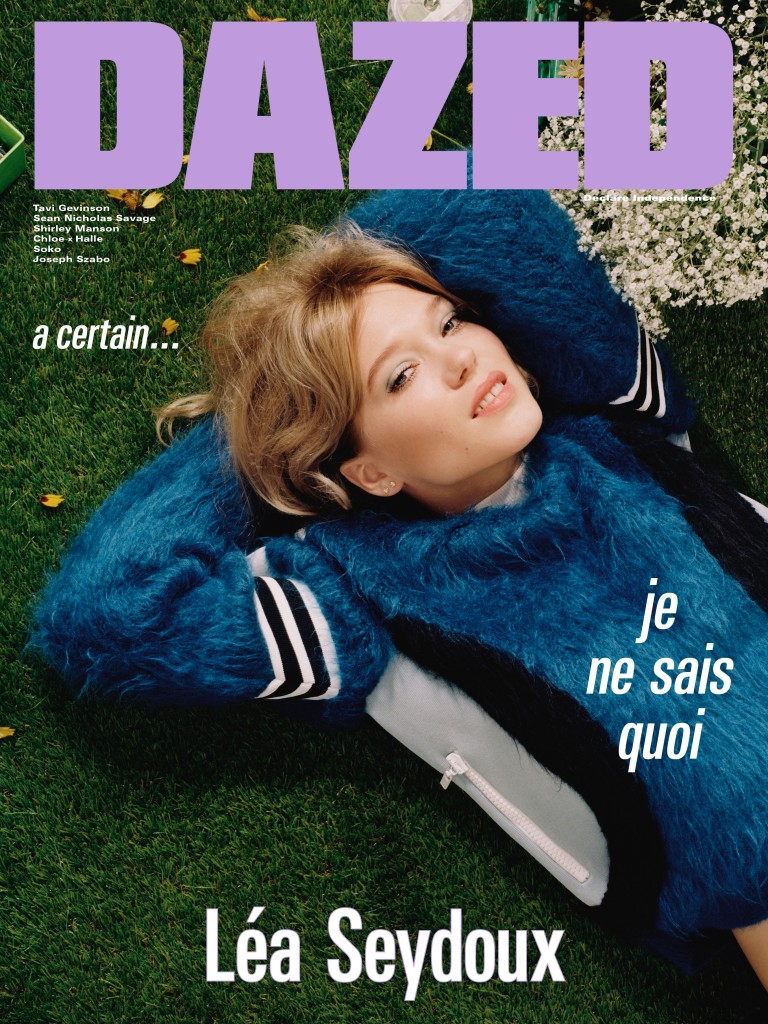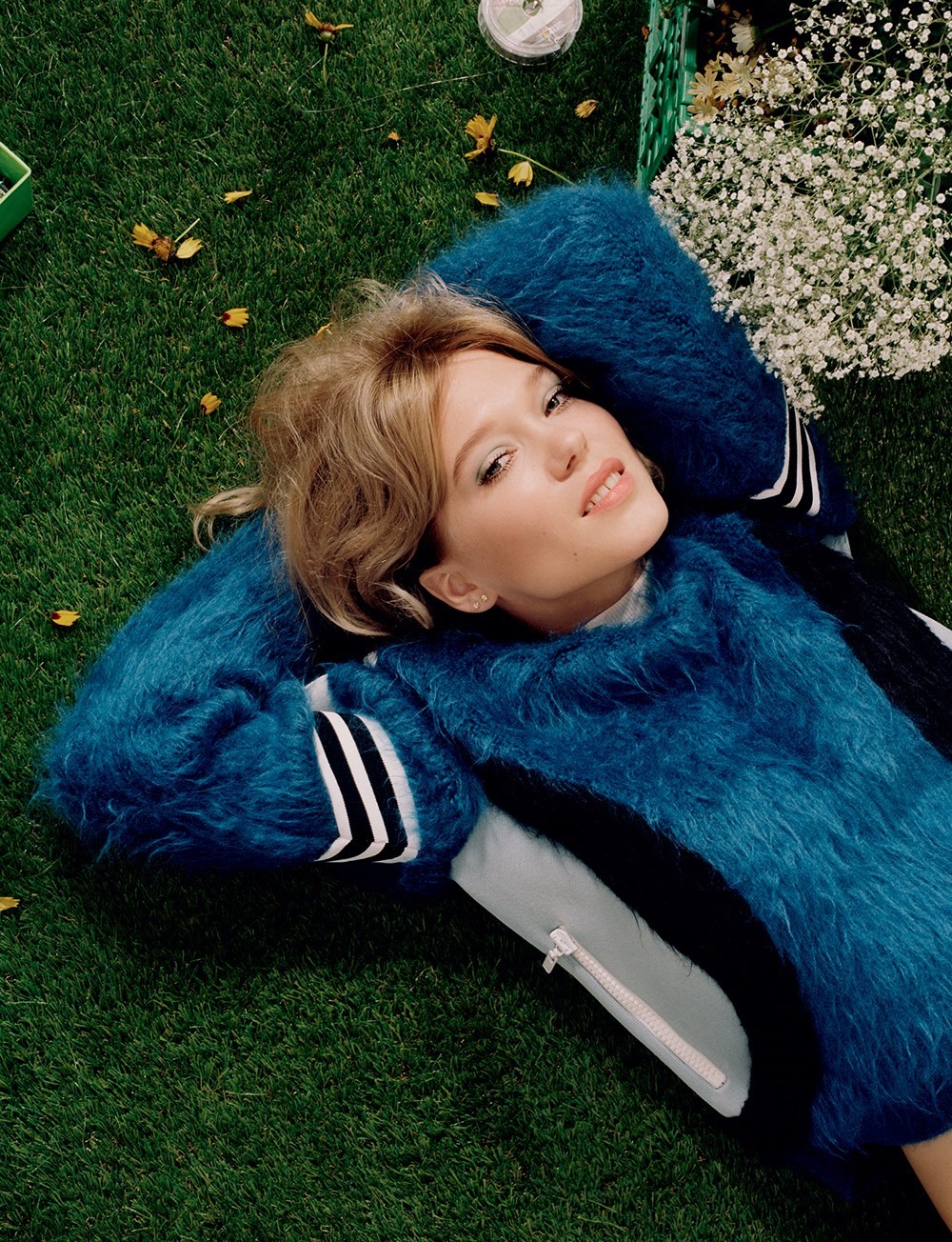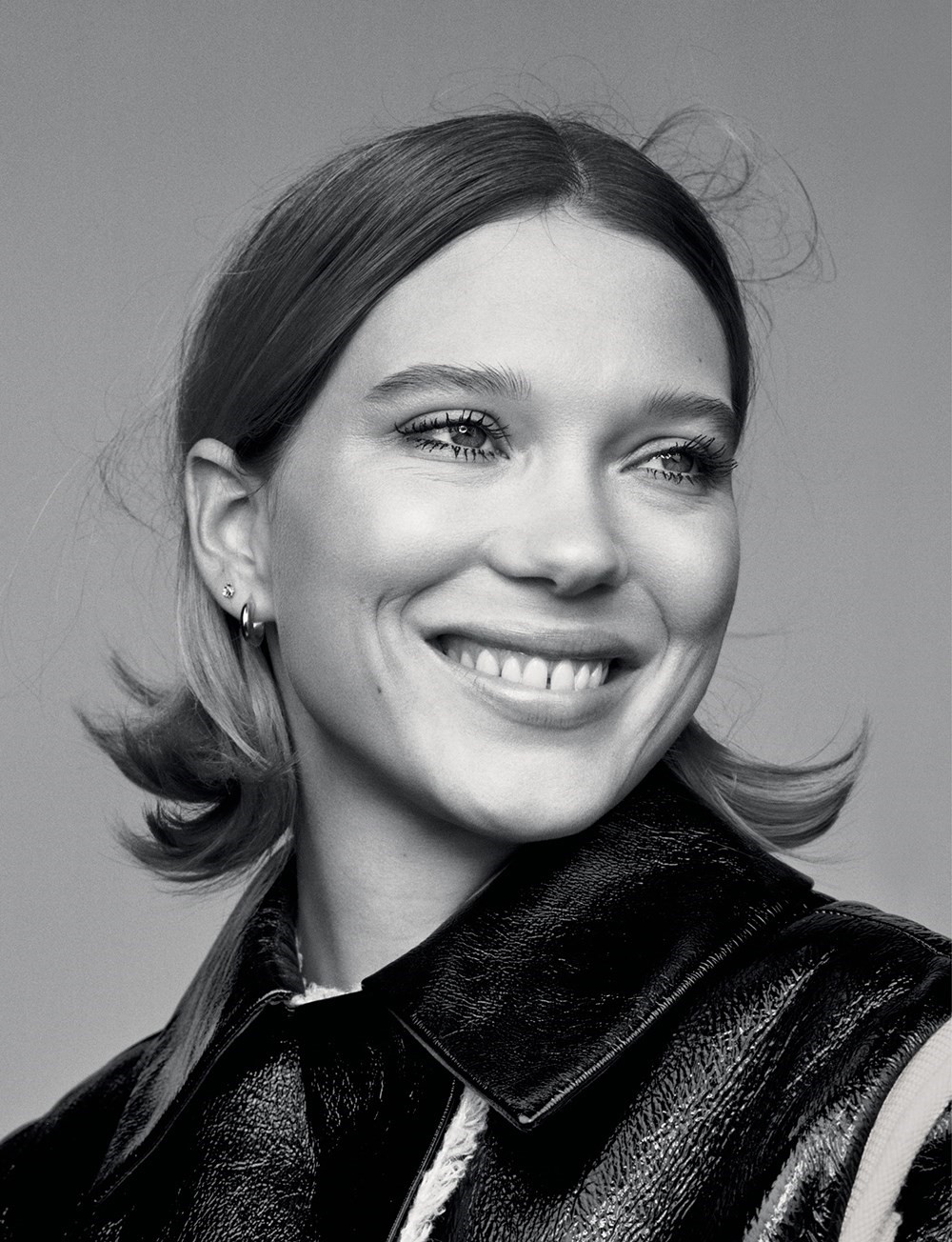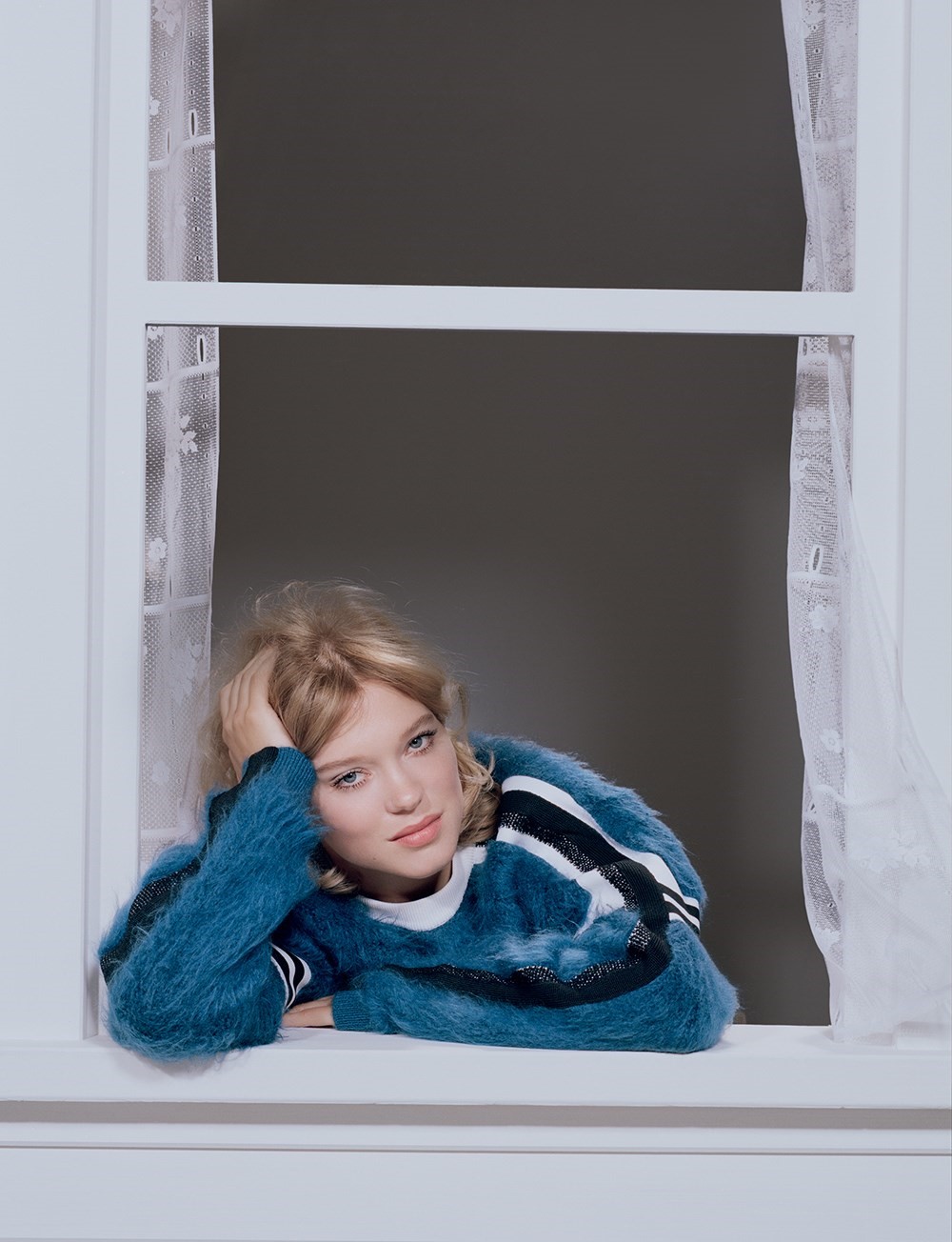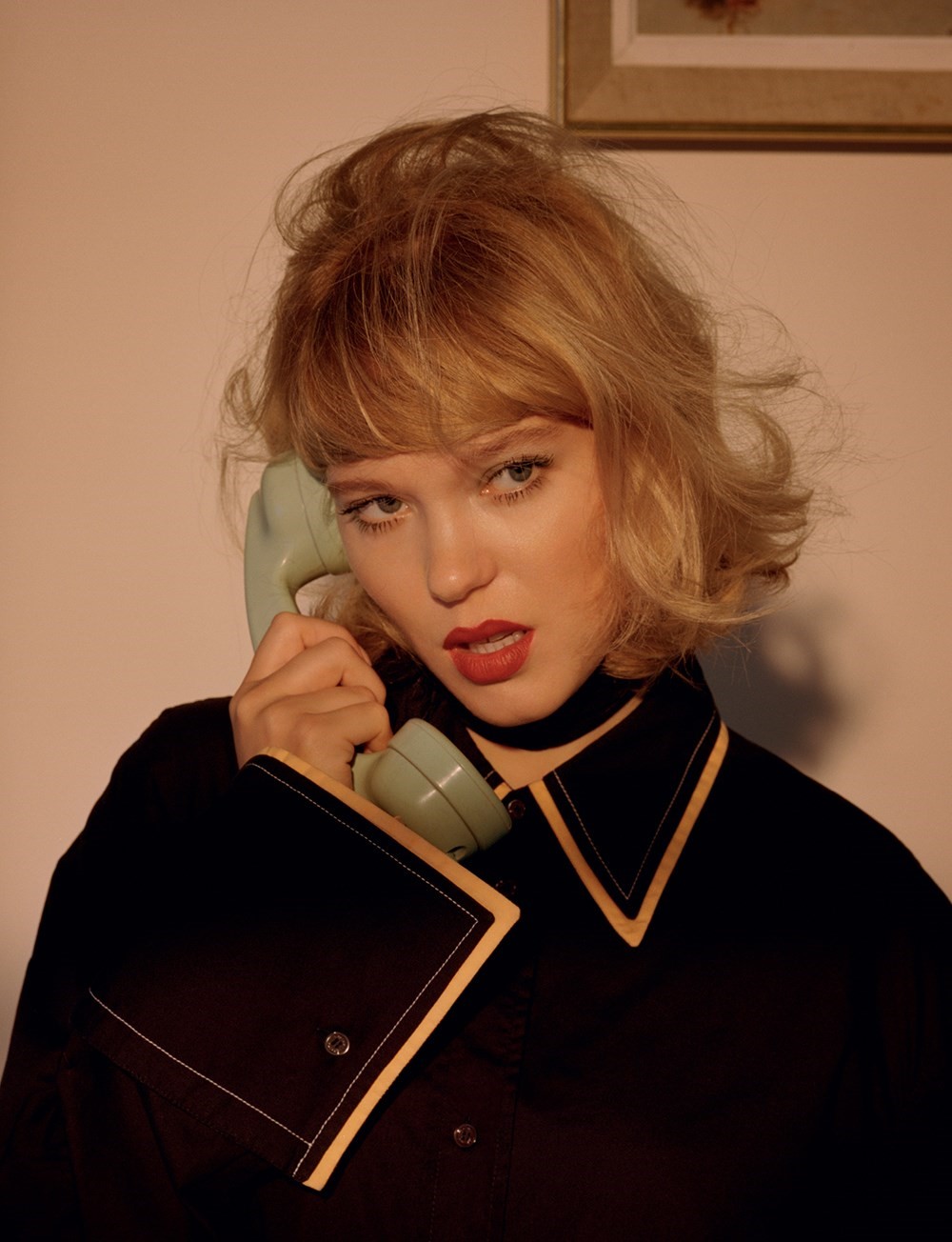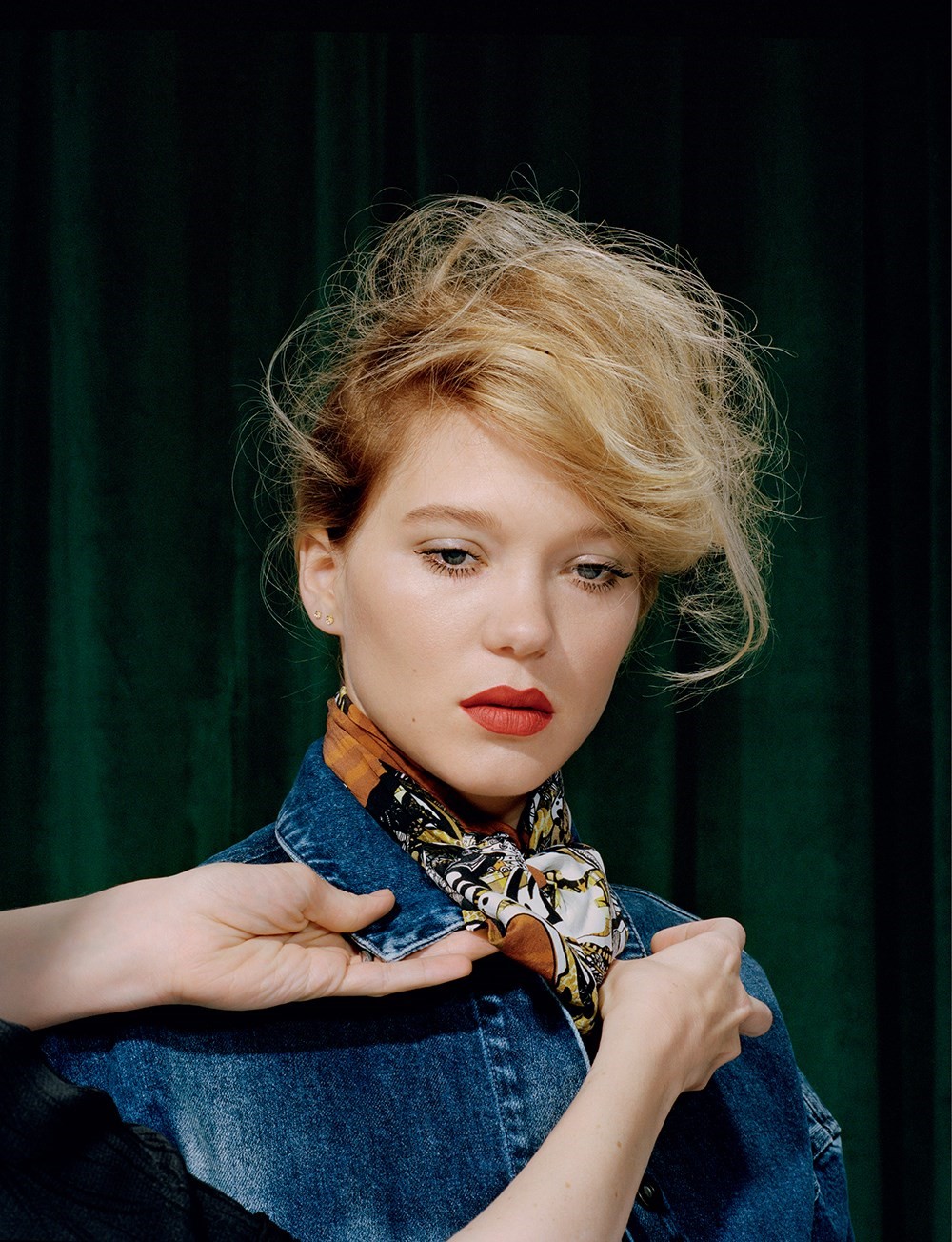“I guess I’m a little on my own planet…” Léa Seydoux exists in a dream world of her own making. She’s brought eccentric élan to the mainstream while embracing the bizarre – now she’s taking her talent to the ends of the earth in Xavier Dolan’s apocalyptic latest. She reveals why fantasy and filmmaking are one and the same
It’s a Tuesday morning like any other in Paris, and Léa Seydoux has arranged to meet me in a cafe in the 14th arrondissement, not far from where the 31-year-old French actress lives. It’s not famous, merely her local, where she can sit in the corner and watch life play out on the street outside.
Seydoux is disarmed and disarming, with the power to draw you in regardless of your sex or sexuality. She wears a black cord Levi’s jacket, oversized to the point you realise it’s probably her boyfriend’s (who remains a mystery). When she smiles, she looks famous, even if everything else about her is racing the other way to remain grounded. Does she feel famous?
“Not really,” she says, in a voice that’s both soft and impassioned, charmed by opposites. “You forget that you’re famous. Here they are not hysterical about fame. I’m happy.”
She is Hollywood’s favourite Gallic girl, having starred in films by Quentin Tarantino, Ridley Scott and indie giant Woody Allen, effortlessly adroit in injecting the mainstream with a stylish flair. Yet she’s also drawn to weird and wonderful WTF roles that defy easy categorisation. If her bio was a meme, it’d be ‘get you a woman who can do both’.
A part Seydoux describes as “eccentric” is her role as Loner Leader in 2015’s The Lobster. A dystopian pairing-off movie featuring Colin Farrell, the plot sees singles arrested and obliged to find a partner in 45 days – if they don’t, they are turned into animals and released into the woods. Leader, a devious outlaw, is so twisted she blinds Short-Sighted Woman (Rachel Weisz) and shows Farrell’s character a good spot to dig his own grave in. She also offers a great line in modern philosophy: “We dance alone. That’s why we only play electronic music.”
One constant is Seydoux’s eye for a challenge and determination not to repeat herself, even if there’s a healthy dose of sexuality in her showreel (her eroticism is ultimately a power she’s in command of). She is elegantly subversive in her choice of roles and the way she carries them, and, in many ways, her current movie is her most troubling yet. It’s Only the End of the World, directed by the enfant terrible everyone’s talking about, Xavier Dolan, is an adaptation of the Jean-Luc Lagarce play, and won the Grand Prix award after making its debut at this year’s Cannes Film Festival.
“My agent called and said, ‘Xavier is thinking of you for a film,’” Seydoux explains. “When a director you admire says that he wants to work with you it’s always a compliment, very good for your ego.” France’s next great actress working with cinema’s next great director on a challenging watch is exactly why we should care, too. “I think every actor should work with Xavier, he’s very talented and unique.”
In Dolan’s film, a writer reluctantly goes back to his hometown after 12 years away, warning his family about his upcoming death. Resentment wells to the surface, fuelled by bitterness and fear, and all attempts at empathy are sabotaged by people’s incapacity to listen, and love. It’s a heightened performance, with a cast that might well be described as a greatest hits of contemporary French cinema: Gaspard Ulliel as protagonist Louis, Nathalie Baye as his mother, Vincent Cassel as older brother Antoine, and Marion Cotillard as Antoine’s wife, Catherine. Seydoux, heavily tattooed, plays Louis’ sister Suzanne, her eyes performing as much as her dialogue, with enormously powerful, soul-staring glances directed across the setting of a dinner table. It’s the talent that drives the movie, a theatre of strained relationships and the irrationality, anxiety and (self-)preservation that manifests when confronted by the big M: mortality.
“There was a good chemistry between all of us,” Seydoux remembers fondly of her experience working on the film. But how does she prepare for such a part? “I just wear the costume, and then…” she says, trailing off like it’s no big deal. Her performance is all the more impressive given that it was filmed at the same time she was doing Spectre, the latest instalment in the James Bond franchise.
“(Xavier) really did everything possible to make it happen, because it was complicated – I was shooting in London then had to go to Montreal,” she says. “Sometimes I was travelling there just for one day. So I was doing eight hours then at the end of the day going back to London. It was crazy. “When you have no choice you just do it, so I was very focused and very concentrated. But it was funny to switch because Xavier and James Bond, it’s a big gap.”
As for her take on the Bond girl, well, she was “tougher, and more sensitive as well. She’s a modern woman in that way. She takes her destiny into her own hands. She’s not passive,” she told AnOther magazine at the time. As the most evolved of a tribe that includes Honey Ryder and Pussy Galore, playing Madeleine Swann – as her character was called – meant teenage boys (and girls) would rip Seydoux’s image out of magazines and stick them to their bedroom walls. She became an idol, idolised.
But Seydoux has never had plans to ‘cross over’ and become a bona fide international – read: English-language – star. She works by instinct, purely on what she finds interesting. And speaks English impeccably, thanks to her years spent at summer camp in the US.
“When I started, I never knew that one day I would have these opportunities. Never,” she says. “I don’t have any preconceived ideas of myself, I just take things as they come. My proudest moment is when I’m part of a good film, when people are touched by it. I had a dream recently where somebody was moved (by a part that I played). More than moved – shocked, even. I do films to touch people. I’m not reading reviews and critics, I don’t care. I guess I’m still a little on my own planet.”
The actress’s big break, of course, came with 2013’s Blue Is the Warmest Colour, a script that, like the majority of her canon (over 30 features and counting), was in her French mother tongue.
Written, produced and directed by Abdellatif Kechiche, the film was based on Julie Maroh’s 2010 graphic novel – proof that it’s not only X Men that can make a successful leap from ink to live action. It’s the story of teenager Adèle’s coming of age – played by actress Adèle Exarchopoulos – as she falls in love with blue-haired artist Emma (Seydoux). A three-hour Palme d’Or-winning opus, it has a seven-minute sex scene as explicit as cinema can get without being sold in a brown paper bag. Depicting blossoming female homosexuality – the ne plus ultra of straight male fantasy – it was always going to be a hot potato among academics and gay rights campaigners, and has enjoyed plenty of debate from all corners. Critically there was unabashed acclaim, with Steven Spielberg calling the romantic drama “magnificent”, and those who watch films for a living awarding it five stars as a celebration of its intimacy.
Did it ever get to the point where it felt like she was standing next to the film, looking on, instead of starring in it?
“You know, I never feel the victim,” Seydoux declares, burying the next question before it arises, about how arduous the movie was to make. Ten days were spent on that sex scene, and 800 hours of footage was shot in total. “I don’t feel overwhelmed.” Seydoux looks deep into you as she says it, and you make a choice to believe her. She is assured, reflective, charming, a realist and intellectually nimble. She embodies all the beauty and complexity of a woman. Having worked with several prominent female directors, including France’s Catherine Breillat (The Last Mistress, 2007), Austria’s Jessica Hausner (Lourdes, 2009) and Switzerland’s Ursula Meier (Sister, 2012), did Seydoux feel that those films differed in the way that women were portrayed?
“I mean, it’s always the director’s projection in any case, whether it’s a man or a woman,” she says. “Even with a woman, it’s her fantasy of a woman. I’m fine with that. It’s like in fashion, with Nicolas (Ghesquière) or Phoebe Philo for Céline, their conception of women. It’s almost always a question of taste.” So it’s not always all about the male gaze or the female gaze, it’s just about fantasy? “Yes, totally. It’s about a dream.”
Seydoux appeared on the cover of the relaunched Lui magazine in 2013, photographed by Mario Sorrenti. An iconic erotic title from the 70s, it’s best described as the French version of Playboy, though its pin-ups are photographed in the proper haute-mode finery you’d see on the fashion side of the newsstand, and on Avenue Montaigne hangers. “It was funny to do something a little ‘olé, olé!’” she grins.
Fashion loves Seydoux as much as cinema does, and it’s true she wears clothes with all the plausibility of her roles. She is friends with Louis Vuitton’s Nicolas Ghesquière and appears on the red carpet in his forward-looking designs, as well as having been photographed by Patrick Demarchelier for the maison, at architect Luis Barragán’s hyper-rose Cuadra San Cristóbal ranch in Mexico. “Léa has mastered the art of mixing different pieces together,” Ghesquière rhapsodises. “Her style, which is so inspiring, is linked to her sense of freedom and spontaneity. Her personality is full of juxtapositions, both soft yet rebellious, ultra-feminine but with a boyish strength.”
“I met Nicolas one year ago and he’s very nice,” Seydoux smiles. “Very simple, very discreet, and at the same time not very discreet because you see him everywhere! He’s a real rock star now. I love the contradiction between his personality and the fact he’s a superstar.”
She has also enjoyed a fashion marriage with Prada, as the coquettish star of a film by Wes Anderson for its Candy perfume.
“He offered me a cameo in The Grand Budapest Hotel and it was nice to be in his universe,” Seydoux reflects. “He has very strong taste and he loves fashion as well. He’s very enigmatic.”
A born Parisian, Seydoux grew up around Saint Germain as one of seven children (she is a product of two French dynasties, the Schlumbergers and the Seydoux, though her parents separated when she was three). While her background has its cinematic heritage – her grandfather, Jérôme Seydoux, is the chairman of Pathé, her grand-uncle Michel Seydoux produced Gérard Depardieu’s Cyrano de Bergerac, and her mother Valérie Schlumberger is a former actress – Seydoux insists that the fractured nature of her upbringing meant none of this carried weight. She fell under the spell of storytelling on her own, perhaps as a way to make sense of things – and living in Paris with the arts all around, why wouldn’t she? You can empathise that Seydoux, who has previously admitted to feeling like an “orphan” growing up, would find solace in embodying different characters.
She cites The Kid by Charlie Chaplin, Disney’s Fantasia and La Belle et la Bête by Jean Cocteau as instrumental in shaping her budding cineaste tendencies, and also professes her love for the films of Nicholas Ray and the French Nouvelle Vague. “When I was 15 I was happy,” she explains. “And then I became very sad when I was 18, 19. I was obsessed with death, obsessed with the idea that it was bigger than my life. Until now. It’s better.”
How did that change?
“Maybe (through) acting, and the fact that I’ve built things in my life. It helps: reality, changeability. I have ambitions for life, to be surrounded by beauty.”
And beauty is?
“It’s a feeling, for me it has to do with poetry. I don’t believe in harmony, though – it doesn’t exist. It’s terrible, no? An invention that makes everything flat. I like the fact that there is no harmony.”
“Maybe (beauty) is a kind of innocence,” she elaborates. “Or maybe it’s an ignorance, (because) I feel disconnected – I’m not into the electronic and digital world and multimedia whatever, I feel a little inept. Unadapted. I don’t know the codes.” She does have an Instagram, leaseydoux_genuine, with 499k followers, but she doesn’t use it very often. There is no Léa Seydoux Twitter, no Facebook, no website – and that’s exactly how she likes it. “(Instagram) is very cinematic,” she says of her one social media indulgence, “and the pictures that people post can transport you in a way.” Voilà.
Days before we meet, Seydoux awarded this year’s LVMH Prize to Grace Wales Bonner, the designer shaking London with a new exploration of black identity. Seydoux lights up at her very mention. “Do you know her? I’m a huge fan of her work!” she exclaims. “I would love to wear her clothes. It was inspiring to meet the young designers (at the ceremony). I love people who create their own language.”
Something you might not know about Léa Seydoux is that, as well as everything else, she’s also funny. We burst out laughing a few times across the table throughout the morning, especially when considering the experience that has most shaped her. (“I need a psychoanalyst to answer this question!”)
“Woody Allen has this phrase, ‘Only real things make you laugh,’” she says. “I like humour that is subtle. And I like surreal humour. (Reality) is so absurd, it makes you cry, and what makes you cry makes you laugh, it’s the same thing.”
Seydoux has the ability to please directors while at the same time twisting her characters just a few degrees so she can arrive somewhere more interesting. The performances she casts are defined by their shadows. She is not at all obvious – and neither is her weakness.
“I wanna be loved, like everybody,” she says, smiling. Which is actually not a weakness at all, more a reminder of universal truth.
LÉA SEYDOUX
TEXT DEAN MAYO DAVIES
PHOTOGRAPHY MARK PECKMEZIAN
FASHION KATIE SHILLINGFORD
DAZED & CONFUSED, AUTUMN 2016
COVER STORY
